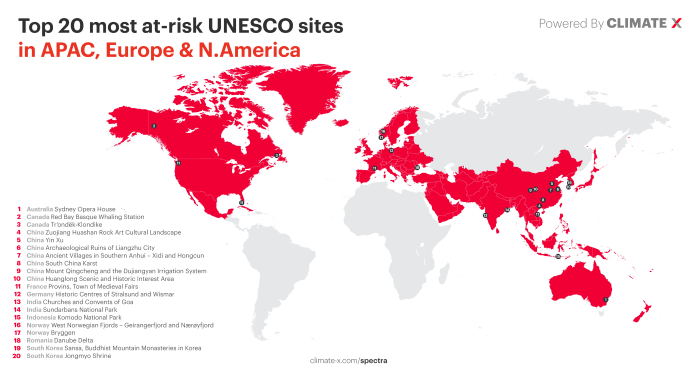New data has identified which UNESCO Heritage Sites are most vulnerable to climate-related damage. The comprehensive analysis highlights that four of the UK’s 35 UNESCO Heritage Sites – The Forth Bridge, St Kilda, and New Lanark in Scotland, as well as Studley Royal Park in Yorkshire – are among the most at-risk sites in the world.

Image Credit: Climate X
Climate risk data analytics company Climate X modelled how climate change will affect 500 UNESCO Heritage Sites around the world, assessing the physical hazards each site faces including flooding, coastal erosion, landslides, wind-based hazards, storms and cyclones. The analysis revealed the following UNESCO Heritage Sites in the UK are among the top 50 most at-risk by 2050 if society does not make concerted efforts to cut greenhouse gas emissions.
- The Forth Bridge, Edinburgh, Scotland
- St Kilda, Scotland
- New Lanark, Lanark, Scotland
- Studley Royal Park, Yorkshire, England
Victorian engineering marvel the Forth Bridge and remote archipelago St Kilda were cited as most vulnerable to coastal flooding risks, while 18th century mill village New Lanark was included in the list for its risk of damage from landslides. In England, Yorkshire’s Studley Royal Park, best known for its landscaped water gardens and 12th-century abbey ruins, is said to be most vulnerable to severe storms. Collectively, these sites attract an annual footfall of over 750,000 visitors, with rich histories and structures dating as far back as 1332.
Other UNESCO sites from around the world at highest risk of climate-related risks include Australia’s Sydney Opera House, the USA’s Olympic National Park, Switzerland’s Swiss Alps Jungfrau-Aletsch and Korea’s Sansa Buddhist Mountain Monasteries. UNESCO selects World Heritage Sites based on their cultural or natural significance through a detailed nomination and evaluation process, requiring them to meet specific criteria of outstanding universal value, integrity, authenticity, and adequate protection and management.
The analysis was done using Climate X’s Spectra platform, which models how climate change will affect properties, assets and infrastructure under various scenarios. The platform’s sophisticated algorithms quantify the risk from extreme weather, providing a Google Maps-like interface and allowing users to model the future likelihood of 16 different climate hazards — from extreme heat to tropical cyclones and flooding — across eight warming scenarios over a 100-year time horizon.
Lukky Ahmed, CEO and co-founder of Climate X said: “The potential impact of climate change on these sites is profound. But it’s not just our past heritage that’s at risk - it’s our present, too. While the loss of these cultural treasures - many of which have endured for millennia - would of course be devastating, it’s also vital to remember the real societal and economic impact of climate change is happening in the here and now. Our findings serve as a stark warning for governments, preservationists, and the global community to prioritise the safeguarding of our planet - to preserve our ancient monuments and our current assets and infrastructure- and to protect life today and into the future.”
Founded in 2020, Climate X is at the forefront of the climate risk data analytics sector, leveraging cutting-edge technology to provide unparalleled insights into the future impacts of climate change. Its platform creates digital twins of real-world assets and models the climate risk to them based on 500 trillion data points to enable customers (including banks, mortgage lenders and real estate firms) to assess the impact of climate change events on their assets or real estate.